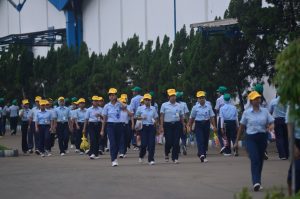Sri Rejeki Isman (Sritex) is one of the largest textile firms in Indonesia. Established in 1978, the company is a major supplier of fabric and garments. In 2020, the firm did nearly $1.3 billion in sales and posted a net profit of $85 million. Thanks to deals with big global brands like Uniqlo and H&M, Sritex has historically been a sizable exporter, with $762 million in overseas sales in 2020 alone.
But the textile giant has been in financial trouble for several years, getting hit hard by the pandemic and never recovering. In 2021, Sritex began a supervised restructuring process, consolidating various liabilities and negotiating a payment plan with creditors. A few weeks ago, a court in Central Java ruled that despite the restructuring plan the firm was insolvent and could no longer continue as a going concern. Normally, this would mean a company must start winding down operations and liquidating its assets in order to partially repay its creditors.
But Sritex is a major source of economic activity in the politically important province of Central Java and according to media reports employs 50,000 workers. The company’s financial statements say the figure is closer to 19,000, but the larger number probably includes the estimated impact on suppliers, wholesalers and so forth.
Fresh off his inauguration, President Prabowo Subianto surely does not want his first few weeks on the job to be marred by the collapse of a major textile firm and the layoff of thousands of Central Javanese garment workers. He has directed the government to find a solution, and assurances have been made that Sritex will continue operating as it appeals the bankruptcy decision and there will not be any immediate job losses.
Sritex’s woes feed into a larger narrative about a weakening in Indonesia’s manufacturing sector, which is causing the middle class to shrink and squeezing purchasing power. These claims need to be scrutinized carefully, but the data does indicate that Indonesians on the lower end of the income scale (a description which applies to many garment industry workers like those employed at Sritex) have seen their purchasing power and earnings contract recently.
What is causing this? That is harder to parse. One narrative ascribes the industry’s struggles to a rise in cheap imports, mainly from China, flooding the market and driving down prices to the point where domestic companies cannot compete. This is one reason Indonesia has been blocking ultra-discount Chinese e-commerce platform Temu. The government also introduced tariffs on textile imports earlier this year to give a boost to the domestic garment industry.
At the same time, there has been a weakening of global demand as countries erect trade barriers and focus on domestic production, which has put export-oriented industries (and countries like Thailand) on the backfoot. Sritex had the added bad luck of taking on large amounts of debt right before this slump in demand and flood of inexpensive imports hit the market.
In 2017, Sritex began issuing bonds. By 2019, the eve of the pandemic, their total bond debt was over $350 million. In 2019, Sritex also took out a $350 million syndicated bank loan, and in 2020 began taking out short-term bank loans probably to cover operational shocks from the pandemic. The firm’s total liabilities ballooned from $848 million in 2018 to $1.6 billion by 2021, the majority of which was bond and bank debt.
In the same year, with international supply chains scrambled thanks to the pandemic, it had to take a $475 million write-down on unsold inventory resulting in a total loss in 2021 of $1 billion. With sales slumping just as debt piled up, Sritex had little choice but to enter supervised restructuring.
Sales have continued declining, from $1.3 billion in 2020 to $325 million last year. Exports also shrank from 60 percent to 49 percent of total revenue, with international clients likely wary of placing big orders given the firm’s uncertain finances. After three years of losses, Sritex’s equity in 2023 stood at negative $955 million.
But help may be on the way. The government is signaling that it will aid the struggling firm, quickly giving Sritex permission to continue exporting while it goes through bankruptcy proceedings. Exactly how far the government will go to save the company remains to be seen. What is clear is that thousands of garment workers being laid off in Central Java could be a political liability, especially given Prabowo’s desire to make social welfare a major theme of his administration.
Debt relief and restructuring can help keep the firm operating in the short term, and allow employees to keep drawing their wages. But a longer-term fix will likely depend on something the Indonesian government has less control over: the rebalancing of the global economy toward a more sustainable equilibrium, one in which global demand has recovered, protectionist tendencies have subsided and countries are no longer erecting trade barriers or dumping their excess production on other markets. Given the results of the U.S. election this week, it is anyone’s guess when such a rebalancing will actually happen.

































